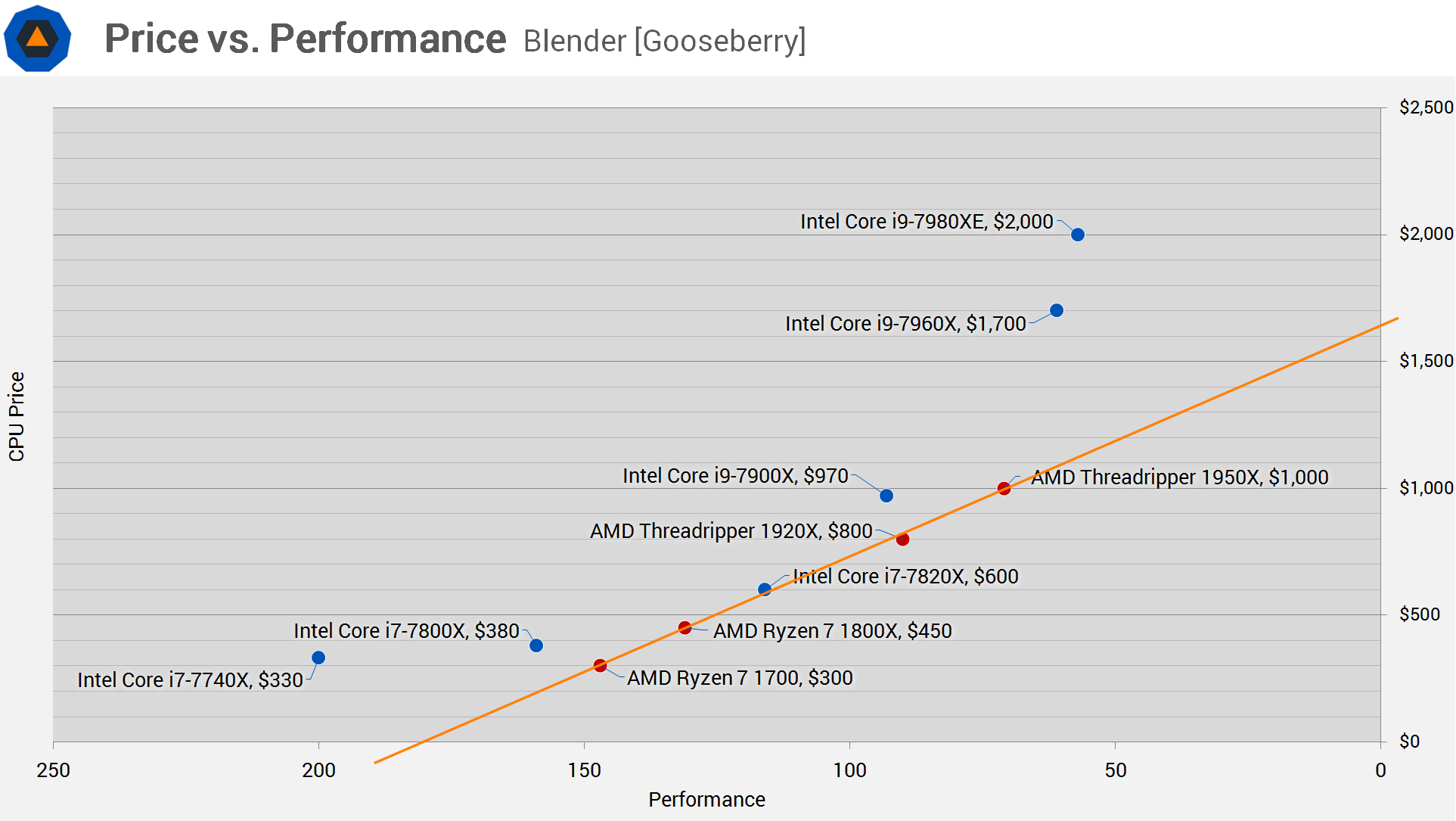Price vs. Performance, Conclusion
As usual we have quite a bit of data to sort through. Of course, it's not just about delivering the best performance and instead most people are interested in bang for their buck.
First up we have Blender, this is a lower is better scenario which is why the numbers at the bottom of the chart work backwards. The faster a CPU the further right it will be and the lower the price the lower it will be situated, so ideally you want to be as far right as possible and as low as possible on the chart.
It's a little confusing so I've added a line indicating the very best value CPUs start from the Ryzen 7 1700 and going up to the 1950X. Anything along this line offers a good balance between price and performance. As you can see the only Intel CPU to touch on this line is the Core i7-7820X.


Looking at HandBrake we see that the Intel Core i7-7800X and i7-7820X look to be mixing it up with the AMD CPUs. Following our linear line from the R7 1700 to the 1950X we see that the 7800X and 7820X actually present as better value options when compared to the AMD CPUs. Even the 7960X moves closer to the line in this test though ultimately isn't great in terms of value while the 7890XE is again horrible.

Finally let's take a look at the price vs performance ratio when testing with Premiere Pro CC. Here we again see the AMD processors look to all deliver a similar bang for your buck while the Core i7-7800X and 7820X are mixed in there as well. Looking at our line we see that the Core i7 CPUs, with the exception of the 7740X, do quite well. The new 7960X and 7980XE, however, don't look so great when it comes to value.
Wrap Up
The price to performance scatter plots summarize the situation quite well. The new Intel Core i9 CPUs are blistering fast in every test but ultimately weren't that much faster than the Threadripper 1950X. Considering the fastest Core i9s cost anywhere from 70 to 100% more, it's hard to justify what often is a 10% increase in performance.
Overclocked, these Skylake-X parts aren't worlds faster either – about 15-20% over an overclocked 1950X yet they draw at least 20% more power. This puts Intel's new 16-core and 18-core CPUs in a bit of a jam if you ask me. Now that we've seen how they perform it looks like the conclusion I drew in my Threadripper 1950X and 1920X review is pretty spot on.
I said at a guess it looked like consumers would need to spend at least $1,400 for the i9-7940X to match AMD's 1950X and I seriously doubted the 40% price premium would be worth it. This certainly looks to be the case now that we've seen the 16-core model in action.
Besides its extreme price, I also noted that the X299 platform's lack of ECC memory support is an issue. Whereas Threadripper supports ECC memory, the Skylake-X chips don't and that means anyone who is serious about their workstation won't even consider Intel's high-end desktop platform.
Finally, I said that unless Intel is willing to move on pricing I couldn't see why anyone would invest in the X299 platform. That was my honest opinion and it's just as true with the arrival of these 16-core and 18-core parts from Intel. Unless I simply had the money to burn, I struggle to imagine a scenario where I would spend $1,000 (100%) more on the Core i9-7980XE to gain at best 20% more performance.
Shopping Shortcuts:
That said, there are businesses that could justify the investment and by being the world's most powerful desktop/workstation CPUs, Intel's new chips aren't irrelevant.
score
Pros: Fastest overall workstation performance available, especially for compression.
Cons: Terrible value compared to AMD's Threadripper chips. No ECC memory support.

